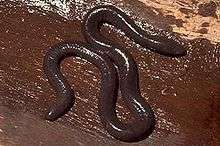Chthonerpeton indistinctum
Chthonerpeton indistinctum is a species of caecilian in the family Typhlonectidae. It is found in northeastern Argentina, Paraguay, Uruguay, and southeastern Brazil. The common name Argentine caecilian has been coined for it.[2]
| Chthonerpeton indistinctum | |
|---|---|
 | |
| Scientific classification | |
| Kingdom: | Animalia |
| Phylum: | Chordata |
| Class: | Amphibia |
| Order: | Gymnophiona |
| Clade: | Apoda |
| Family: | Typhlonectidae |
| Genus: | Chthonerpeton |
| Species: | C. indistinctum |
| Binomial name | |
| Chthonerpeton indistinctum | |
| Synonyms[2] | |
|
Siphonops indistinctus Reinhardt and Lütken, 1862 "1861" | |
Description
Chthonerpeton indistinctum is a snakelike amphibian with no limbs. It can grow to about 53 cm (21 in). The body has 70 to 80 transverse folds, giving it a segmented appearance. The head has a pair of sensory tentacles between the nostrils and the eyes, and this area of skin is white. The body is black above and dark grey beneath, both with tiny white flecks. The flat, disc-like area surrounding the cloaca is creamy white.[3]
Distribution and habitat
C. indistinctum is found in Paraguay, Uruguay, Brazil and Argentina at altitudes ranging up to 1,000 m (3,300 ft). It is partially terrestrial and partly aquatic, possibly having annual migrations. When on land, it mostly stays close to the river bank, but occasionally ventures some way from water. Occasionally, it gets washed out to sea on mats of vegetation and has been found alive in the brackish water of estuaries. It is a common species, sometimes occurring in very large numbers, and the IUCN Red List of Threatened Species lists it as being of "Least Concern".[1]
Biology
This species is viviparous, giving birth to live young.[1]
It is considered to have several characteristics which indicate it is more primitive than other, more highly derived species. As caecilians evolved, their chromosomes are thought to have reduced in number. A number of species were karyotyped, and C. indistinctum was found to have a diploid number of 20 as against one of 28 for the more derived Typhlonectes compressicauda, an unexpected result. Further study is expected to clarify the taxonomic relationships between different species of caecilians.[4]
References
- John Measey; Magno Vicente Segalla; Débora Silvano; Jose Langone; Jorge Céspedez (2004). "Chthonerpeton indistinctum". IUCN Red List of Threatened Species. 2004. Retrieved 2012-09-13.
- Frost, Darrel R. (2017). "Chthonerpeton indistinctum (Reinhardt and Lütken, 1862)". Amphibian Species of the World: an Online Reference. Version 6.0. American Museum of Natural History. Retrieved 2 July 2017.
- Franziska Sandmeier (2001-02-23). "Chthonerpeton indistinctum". AmphibiaWeb. Retrieved 2012-09-13.
- M.H. Wake; J.C. Hafner; M. S. Hafner; L.L. Klosterman; J. L. Patton (1980). "The karyotype of Typhloneetes compressicauda (Amphibia: Gymnophiona) with comments on chromosome evolution in caecilians" (PDF). Experientia. 36 (2): 171–172. doi:10.1007/bf01953713.
